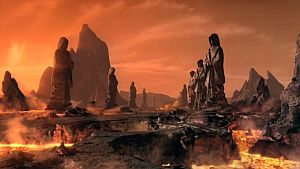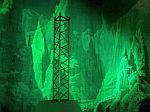
|
|
Star LoreIn 20th / 21st Century
|
|


It is, of course, impossible, to list all astronomical references in modern literature, music and cinema on one page.
 This very short and very bias selection was dictated by the author's personal taste.  For the perhaps most comprehensive list on the subject, check out Wikipedia's Stars and planetary systems in fiction. |



|
|
Aquarius
The Age of Aquarius was part of a medley of two songs written for the 1967 musical Hair
by James Rado and Gerome Ragni (lyrics),
and Galt MacDermot (music), released as a single by American R&B group The
5th Dimension. The song spent six weeks at number one on the US Billboard Hot 100 pop singles
chart in the spring of 1969.
|

|



|
|
Canis Major
In The Caves of Androzani, the sixth serial of the 21st season of the British science
fiction television series Doctor Who, the colonized (fictional) planets Androzani Major and
Androzani Minor are part of the Sirius system.
For a comprehensive list of Books and Films about Sirius, see |
 The Caves of Androzani
The Caves of AndrozaniSource: DVDCA.com |



|
|
Canis Minor In the Star Trek Universe, Andoria, a moon orbiting the eights planet of Procyon is the home world of the Andorians, one of the four founding members of the United Federation of Planets.
Another (fictional) planet of the Procyon system is the scene of the Battle of Procyon V in the episode
Azati Prime of the TV series Star Trek: Enterprise.
|

|



|
|
Centaurus
In the 2009 science fiction film Avatar, director
James Cameron conceived a fictional universe in orbit of
Alpha Centauri A.
For a comprehensive list of Science Fiction focusing on Alpha Centauri, see Wikipedia's Alpha Centauri in fiction. |
 Artist's concept of fictional moon Pandora and planet Polyphemus
Artist's concept of fictional moon Pandora and planet PolyphemusSource: Wikipedia |

In the television series Babylon 5, Proxima III is an Earth Alliance colony that
seceded from the Alliance when Earth became a dictatorship in 2260.
 Source :Wikipedia |
 The Battle of Proxima III
The Battle of Proxima IIISource: babylon5.fandom.com |

The Photon Ship (Фотонният звездолет) was a science fiction novel, written in 1964 by Bulgarian writer
Dimitier Peew.
 The novel told the fictional story of humanity's first expedition to Proxima Centauri.  It was the first science fiction novel, the author red (at age 12). It laid the foundation for over half a century of fascination with the stars, whithout which this site would have never happened. |
 The Photon Ship
The Photon Ship
|



|
|
Coalsack Nebula
The Coalsack Nebula is mentioned in two episodes of
Star Trek: The Original Series:
|
 memory-beta.fandom.com
memory-beta.fandom.com
|



|
|
Crux
Southern Cross is a song written in 1981 by Stephen Stills, Rick Curtis, and Michael Curtis and performed by the rock band
Crosby, Stills & Nash.
|

|



|
|
Eridanus
In some maps of the Star Trek universe, the planet Vulcan
is shown to orbit 40 Eridani.
|
 Artist's concept of the Star Trek universe planet Vulcan
Artist's concept of the Star Trek universe planet VulcanSource: denofgeek.com |

Part of The Art of the Impossible,
a 2003 novel of Star Trek: The Lost Era takes place in the
Cursa System, the (fictive) planetary system of
Cursa (β Eridani).
 The system is controlled by the Klingon Empire, and is attacked by the Cardassian Union in the year 2333.  Source: Wikipedia |
 Cursa System
Cursa SystemStar Trek Gamepedia |

The location of The Vengeance Factor, a 1989 episode of
Star Trek: The Next Generation is
Acamar III, the (fictive) third
planet of Acamar (θ Eridani), where the crew learns of a group of
Acamarian nomadic pirates known as the Gatherers.
 Source: Wikipedia |
 Acamar III
Acamar IIImemory-alpha.fandom.com |

In the Dune universe by
Frank Herbert, "Eridani A" is orbited by the planet Richese (the fourth planet in orbit).
Richese and Ix are "supreme in machine culture"; their devices are commonplace and considered essential throughout the Dune universe.
 Source: Wikipedia |
 Dune: House Atreides
Dune: House AtreidesSource: amazon.com |



|
|
Gemini
In Who Mourns for Adonais?, an episode of
Star Trek: The Original Series, the crew visits the (fictional) planet
Pollux IV.
|
 Pollux IV
Pollux IVSource: alpha.fandom.com |



|
|
Hydra
In The Deadly Years, an episode of
Star Trek: The Original Series, the crew visits the (fictional) planet
Gamma Hydra IV.
|
 Gamma Hydra IV
Gamma Hydra IVSource: alpha.fandom.com |



|
|
Leo
Wolf 359 (CN_Leonis) is a red dwarf of apparent magnitude 13.5 and thus can only be seen with a large
telescope. However, at approximately 7.8 light-years away it is the seventh-closest stellar system to the Sun. Thus, even though it is suspected to
be a flare star, it has attracted the attention of science fiction authors, filmmakers, and game developers. For a comprehensive list, see Wikipedia's
Wolf 359 in Fiction.
|

|



|
|
Lyra In the television series Babylon 5 the Vega Colony is an outpost world of the Earth Alliance in the Vega star system.
In the movie Contact, written by
Carl Sagan and Ann Druyan, and directed by
Robert Zemeckis,
SETI researchers, using the
Very Large Array (VLA) in New Mexico, detect a message from an extraterrestrial
intelligence, sent from a transmitter array orbiting Vega.
For a comprehensive list of Science Fiction focusing on Alpha Centauri, see Wikipedia's Vega in fiction. |

|



|
|
Orion
As one of the brightest and best-known stars, Betelgeuse (α Ori) has been featured in many works of fiction. The star's unusual name inspired the title of the
1988 film Beetlejuice, and script writer Michael McDowell was impressed by how many people made
the connection.
|
In the popular science fiction series The Hitchhiker's Guide to the Galaxy
by Douglas Adams, one of the main characters,
Ford Prefect was from "a small planet somewhere in the vicinity of Betelgeuse."
 Source: Wikipedia |
 Ford Prefect;
Screenplay
Ford Prefect;
Screenplay
|

In the Star Trek Universe, Rigel (β Ori) is orbited by
at least ten planets, six of which are inhabited.
 For details, see alpha.fandom.com and Wikipedia's Rigel in Fiction, which offers a comprehensive list of movies and novels around Rigel. |
 Rigel VII;
alpha.fandom.com
Rigel VII;
alpha.fandom.com
|

In Wolf in the Fold, an episode of
Star Trek: The Original Series, the crew visits the (fictional) planet
Argelius II, a planet orbiting Iota Orionis.
 Source: Wikipedia, alpha.fandom.com |
 Argelius II;
alpha.fandom.com
Argelius II;
alpha.fandom.com
|

In Who Watches the Watchers, an episode of
Star Trek: The Next Generation, Mintaka III a planet orbiting
Mintaka (δ Ori) is inhabited by the Mintakans, a preindustrial Vulcan-like race that is under
observation by the Federation.
 Sources: Wikipedia, alpha.fandom.com |
 Mintaka III;
alpha.fandom.com
Mintaka III;
alpha.fandom.com
|



|
|
Taurus As one of the brightest and best-known stars, Aldebaran (α Tau) has been featured in many works of fiction. For an extensive list, see Wikipedia's Aldebaran in fiction.
The 1967 song 2000_Light Years from Home by
The Rolling Stones ends with:
|

|


Aldebaran Whiskey is an alcoholic beverage that appeared in several episodes
of the Star Trek Universe, notably in the
Star Trek: The Next Generation's episode
Relics.
 Sources: alpha.fandom.com |
 Aldebaran Whiskey
Aldebaran Whiskey
|
 Data to Scotty: "It is green"
Data to Scotty: "It is green"alpha.fandom.com |
In The Galileo Seven, an episode of
Star Trek: The Original Series, Spock makes an emergency landing on the

An AMT Model Kit features Spock engaging an
Aldebaran serpent, a three-headed serpent mentioned in the
Star Trek Encyclopedia.
|

|

|


Ursula K. Le Guin's 1971 novel
The Lathe of Heaven describes a fictional alien invasion of
Earth's lunar colony Moondome by "natives of a methane atmosphere planet of the star Aldebaran..."
 Source: Wikipedia |
 goodreads.com
goodreads.com
|



|
|
Ursa Major
In Strange New World, an episode of
Star Trek: Enterprise, the crew visits the (fictional) planet
Archer IV.
|

|



|
|
Ursa Minor
In the best selling comedy science fiction series
The Hitchhiker's Guide to the Galaxy by
Douglas Adams, Light City, the only city on the planet
Ursa Minor Beta is where the headquarters of the editorial offices of
The Hitchhiker's Guide to the Galaxy are situated.
|
 When you are tired of Ursa Minor Beta you are tired of life
When you are tired of Ursa Minor Beta you are tired of lifeSource: Shirt Woot
|


|
Back to Star Lore |
Back to Mythology |
Back to Space Page |
Back to English |
 Back to Start Page |